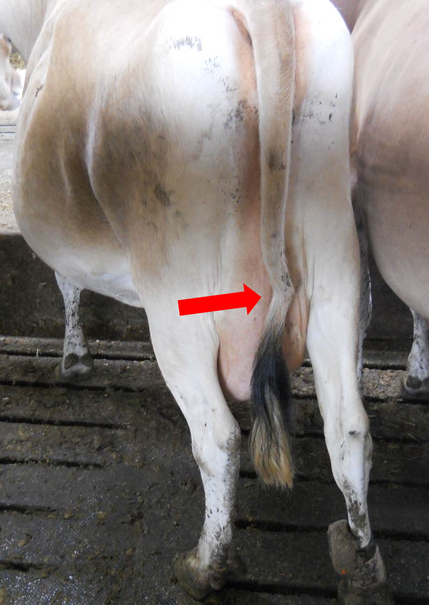Injured tails can result from poor stockmanship and rough handling and also, to a lesser extent, pinch points in the animal's environment. Injuries are often present near the base of the tail due to extreme force when applying a tail twist or jack for restraint. They can also appear mid-length or at the tip of the tail due to bending it over other structures in an attempt to restrain an animal.
This instructional video by the University of Saskatchewan demonstrates the proper way to apply a tail twist.
This instructional video by the University of Saskatchewan demonstrates the proper way to apply a tail twist.
Which animals to assess:
Score the pen of cows scored for hygiene.
When to assess:
Only standing animals will be evaluated. All classes of animals should be scored around feeding to facilitate this. If groups of animals are lying down, it is recommended that the auditor walk quietly amongst the animals, as this will often encourage them to stand. Cattle should be left lying if they do not rise after a calm walking of the pen.
Cows suspected to be non-ambulatory may be encouraged to stand (gentle knee to the rump) to evaluate their ability to stand.
Tails should be evaluated from the rear of the animal. This may be done while animals are eating, milling around or being milked in flat-barns or tiestalls. Side views are not acceptable, and animals should be close enough (within 5 feet, or 1.5 meters) such that subtle swellings can be consistently noted. It is not necessary to, nor should auditors touch the tails to score. Some parlors may be designed in such a way that the full length of the tail can be observed from behind without obstruction. In such cases, tails may be scored in the parlor as long as the auditor can keep up with the pace of scoring hocks and knees without disrupting parlor flow.
If the number of standing animals able to be scored is less than required by the sample calculator, use the number scored and provide an explanation in the comment section.
Cows suspected to be non-ambulatory may be encouraged to stand (gentle knee to the rump) to evaluate their ability to stand.
Tails should be evaluated from the rear of the animal. This may be done while animals are eating, milling around or being milked in flat-barns or tiestalls. Side views are not acceptable, and animals should be close enough (within 5 feet, or 1.5 meters) such that subtle swellings can be consistently noted. It is not necessary to, nor should auditors touch the tails to score. Some parlors may be designed in such a way that the full length of the tail can be observed from behind without obstruction. In such cases, tails may be scored in the parlor as long as the auditor can keep up with the pace of scoring hocks and knees without disrupting parlor flow.
If the number of standing animals able to be scored is less than required by the sample calculator, use the number scored and provide an explanation in the comment section.
How to assess:
Count and record the % of animals with injured tails (Goal: less than 5%). This benchmark is based on the top 25% of farms with available data.
Tails that have recently been injured will be swollen, may have abrasions and/or crusted blood around the broken vertebrae, or the tip of the tail may have necrosed and fallen off. Injured tails that have healed will often present with permanent crooks or bends in the tail.
Tails that have recently been injured will be swollen, may have abrasions and/or crusted blood around the broken vertebrae, or the tip of the tail may have necrosed and fallen off. Injured tails that have healed will often present with permanent crooks or bends in the tail.








